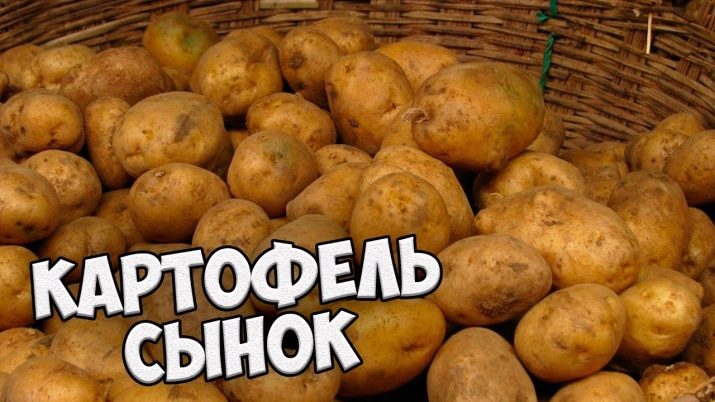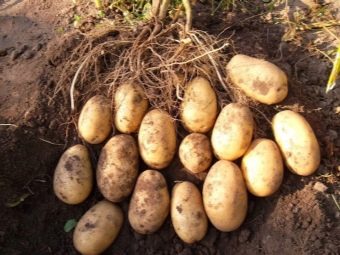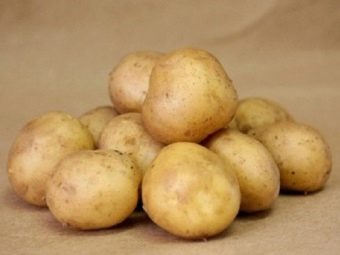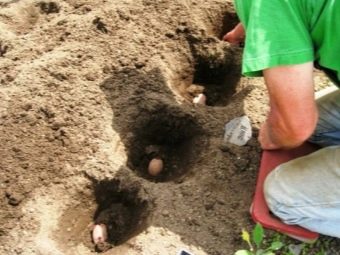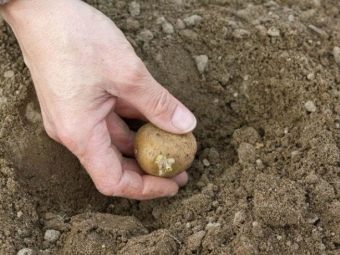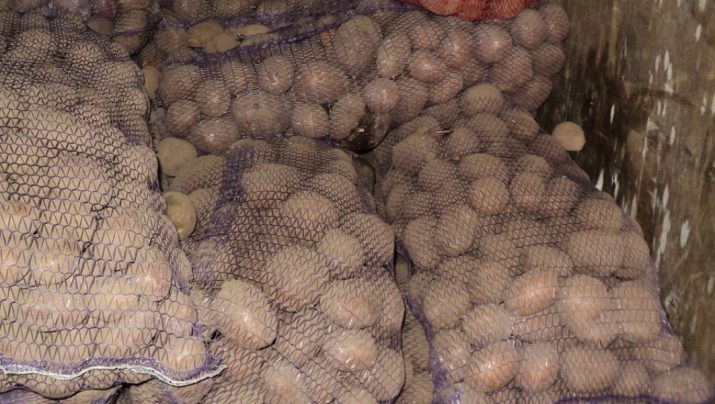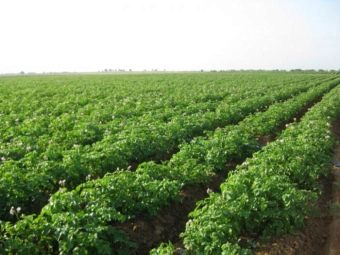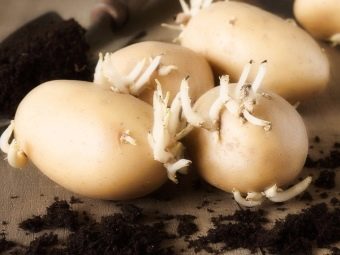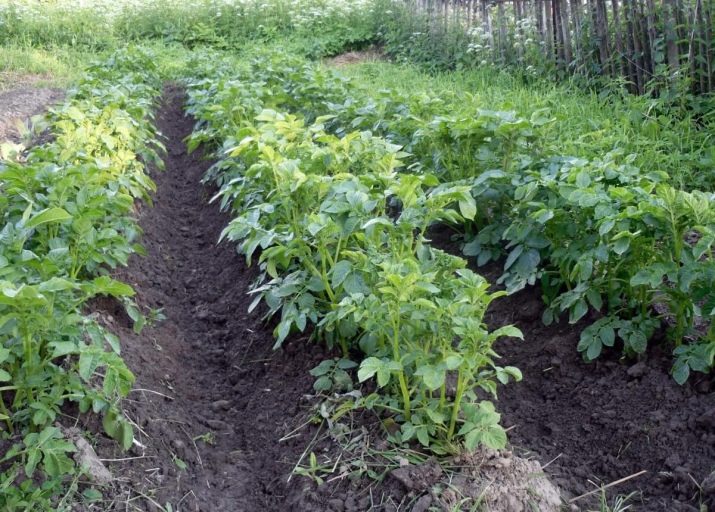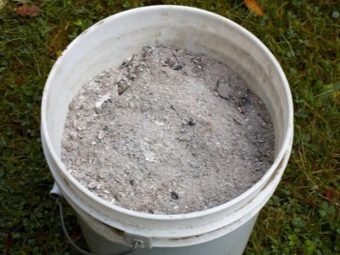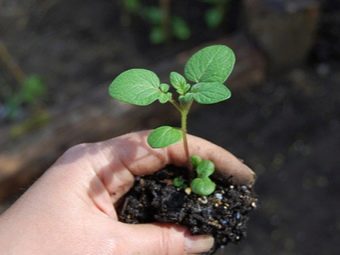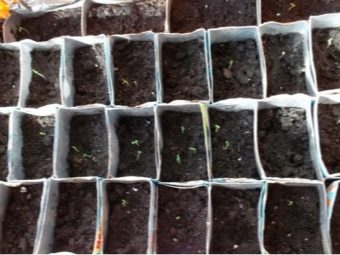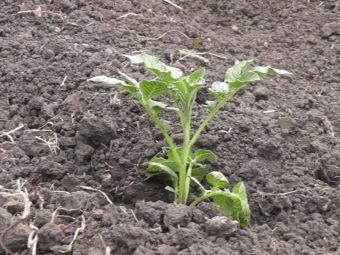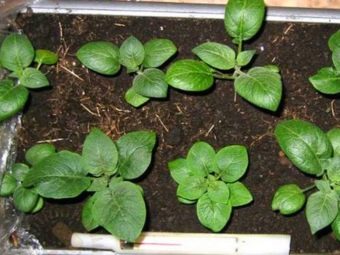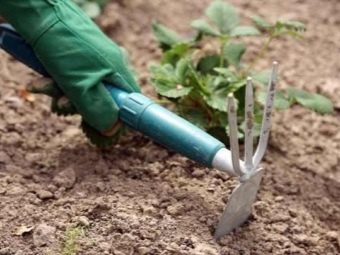Characteristics and cultivation of varieties of potatoes "Sonny"
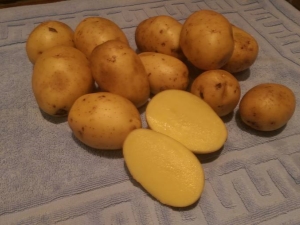
Potato varieties "Sonny" appeared relatively recently, he did not pass the varietal tests and has no registration in the State Register.However, experienced gardeners and owners of private plots are well aware of this variety and speak of it only positively.
Description
Variety "Son" is the result of breeding. Varieties of late and medium maturity were used as parental pairs. The plant is characterized by high erect shrubs, reaching a height of 70 cm and have a moderate spreading. Elastic stems are covered with leaves of a simple type, having weakly wavy edges and a juicy green color. The leaves are able to stay on the bush until the time of harvest. The volume of bushes depends on the degree of soil fertility: the more nutrient the environment is, the more green mass the plant will have.
The culture is distinguished by its rapid flowering with a large number of white flowers, each of which fades in on average in 3 days. The root system of plants is very well developed, making it possible to collect from 15 to 25 tubers (up to 8 kg) from one bush. This is an excellent indicator and favorably distinguishes "Sonny" from other varieties.
Productivity depends on environmental conditions, planting method and soil fertility.
Potatoes are about the same size, can have a mass of from 80 to 350 grams. On highly fertile soils, the weight of tubers often reaches 400-450 grams, for which the variety “Sonny” received the second name - “Bogatyr”.
The location of the tubers depends on the type of soil, but in general the distance from the center of the bush to the extreme potato is no more than 40 cm. The depth may vary from 8 to 35 cm. The eyes on the tuber are usually small, all of them are concentrated on the upper part. Potatoes have a creamy pink skin with a mesh structure and dense homogeneous pulp of bright white color, not darkening during cutting and heat treatment.
The vegetation period of plants ranges from 120 to 140 days, so that the variety is most prevalent in areas with a warm climate and late frosts. Due to the long ripening time, the tubers have time to accumulate a huge amount of nutrients and are distinguished by the presence of various vitamins and microelements. The starch content in potatoes is average, is in the range of 13.4-14%, so that the potato does not boil soft, does not crumble, does not change color and is suitable for cooking any dishes.
An important characteristic of the variety is the possibility of long-term storage and transportation over long distances. The harvest is perfectly preserved until the next season, it does not require strict observance of temperature conditions and can be stored at any humidity. Even tubers damaged during harvesting are not subject to rotting and drying. "Son" is characterized by persistent immunity to potato cancer, scab, nematode, rot, viral infections and black leg.
The only weak point of the variety is the low resistance to late blight, which is a scourge of potato crops.
Advantages and disadvantages
A large number of positive reviews about the potato "Sonny" due to a number of indisputable advantages of this variety.
- Unpretentious care. The plant is quite resistant to extreme temperatures, does not require regular watering and tolerates both insufficient and excessive moisture.
- High resistance to common diseases allows you to grow potatoes on soils that previously were varieties susceptible to one or another potato ailments.
- The possibility of transportation and long-term storage is one of the most important qualities of the variety. Tubers are perfectly preserved throughout the year, without requiring special conditions.
- Increased yield and one-dimensional tuber.
- Excellent taste and high nutritional value.
The disadvantages of "Son" include the lack of certification and registration in the State Register, which led to the emergence of rumors about the transgenic nature of the variety.Unfortunately, due to the lack of tests of the species and the lack of information about its origin, it is impossible to either confirm or refute these assumptions.
Reproduction tubers
Growing potatoes "Sonny" can be done in two ways. The first is planting tubers, is the most simple and less labor-intensive. Previously harvested tubers, carefully selected and stored separately for a year, are used as seeds. Seeds should be selected medium-sized potatoes with no defects or damage.
Shrubs, from which the seeds are taken, must be healthy, well developed, with strong and resilient stems and unfolded leaf plates. If the bush has formed less than 10-14 tubers, the seeds from it should not be taken. On average, one hundred square meters of land must be harvested 45 kg of seed potatoes. With a shortage of planting material, it is allowed to cut a tuber into several parts, provided that each of them has an eye.
In order to obtain seed tubers in sufficient quantities, it is recommended to plant the plants at a distance of 15 cm from each other. This will lead to the formation of a large number of small potatoes, which will serve as a good planting material.
Before planting, it is recommended to place the tubers in the light for primary germination. Potatoes are placed in a well-lit place at an air temperature of at least 15 degrees. It is better to have tubers in 2-3 layers on the floor or in a box, although germination in mesh bags is also allowed. The main key to success in this case is the access of air and good lighting. The germination process takes about 40 days.
At night, the temperature is recommended to reduce to 6 degrees. This will prevent the sprouting out and will contribute to the formation of a strong and healthy process. To maintain optimum moisture levels, dry rooms should be moistened daily with a sprayer or a special device. The best option for planting are tubers with strong and thick shoots 10-12 mm long. Planting can begin only when the soil temperature reaches 8 degrees.
Potato varieties "Sonny" grows well on any soil, can be planted in areas after growing cabbage, cucumbers, melons, alfalfa and meadow herbs. The only restriction for planting and growing potatoes is the land from under the tomatoes.
Despite the fact that the variety is quite unpretentious and can grow in any conditions, in order to get a good harvest, it is recommended to select areas that are sunny and not covered by the wind. The soil must be perekopan and leveled. When applying fertilizer to an area that has not yet been planted, it is important to remember that fertilizing the potato field with manure or clean peat is not recommended.
The most favorable and affordable option is the use of wood ash.
Planting seeds
The second method of reproduction of potatoes is the germination of plants from seeds and the subsequent transplanting of seedlings. The method is applied when there is a shortage or complete absence of seed tubers, as well as with the "degeneration" of potatoes. The advantages of this technology are low cost and long shelf life of seeds, increased yield, which allows to increase the number of harvested potatoes by 25%, higher plant resistance to diseases and the possibility of self-study in selection. The disadvantages include the laboriousness of the process and getting a full harvest only in the second year.
This method can be used only if the warm period is sufficiently long. For zones with a sharply continental climate, seedling technology is not suitable. When germinating seeds collected independently from the previous crop, it should be remembered that maternal varietal characteristics in this case are not preserved.
Sowing should be done at the end of March.Pre-seeds are recommended to harden, placing them at night in the refrigerator, and in the daytime - having warm. Then the seeds should be soaked for several days, covered with a soft napkin and processed with growth stimulants, for example, "Appin" or "Zircon". After the seeds germinate, they are planted in the soil, for the preparation of which you can take the garden soil and peat, mixing them in a ratio of 1: 4.
In the substrate obtained, it is necessary to make furrows up to 1 cm in depth, and, placing the seeds there, cover with sand. The distance between adjacent seeds should be 10-15 cm. It is desirable to carry out watering daily, and loosening is permissible only after the seeds have grown. The air temperature in the room should not fall below 17 degrees, otherwise the growth of young shoots will be slowed down. In this case, the plants do not have time to finally get stronger before transplanting into open ground.
After 25 days after the shoots reach a height of 8 to 10 cm, you can begin to dive shoots into separate containers. Deepen the plants should be up to the level of the arrangement of cotyledon leaves. After transplantation, sprouts are recommended to be fed with a mixture of ammonium nitrate and water, taken in a proportion of 1 g / l, and then watered with warm water. Young shoots can be planted in open ground 40 days after sowing seeds. Sprouts by that time reach a length of 20 cm and become viable independent plants.
Transplantation of seedlings in open ground is carried out in the second decade of May. At the site, dig pits with a depth of 15 cm, put 300 g of humus in each and pour out a pint of water. Then you can start planting young shoots. The depth of planting should be calculated so that 2-3 leaves remain on the surface.
Care
The main types of work for the care of potatoes are weeding, loosening, hilling and, if necessary, watering.
- Loosening and removing weeds should be made as often as possible. This will provide air flow to the roots and help the tubers to ascend faster.
- Watering should be carried out during the flowering period. If you start watering long before the appearance of the buds, the tops will quickly grow, and then quickly wither. In particularly dry periods, watering should be carried out at intervals of 2 weeks. The complete lack of moisture can lead to cracking of the tubers and a general decrease in yield.
- Hilling produce from mid-June to flowering. This event contributes to the proper formation of root crops and significantly strengthens the stems. To avoid disturbing the heat balance, high hilling is not recommended. Mulching with straw or mowed grass gives a good effect. This allows you to maintain optimum soil moisture and leads to a marked increase in crop productivity.
Potatoes "Sonny" is a unique variety for the Russian climatic conditions. Due to its excellent taste and high nutritional value, the culture is in high demand and is increasingly being chosen for cultivation.
In the next video, see the review of the varieties of potatoes "Sonny".

